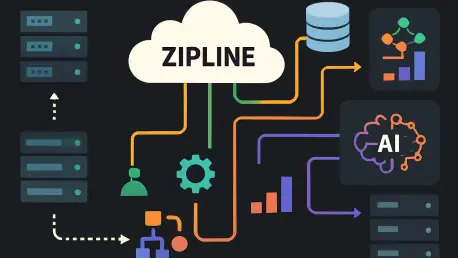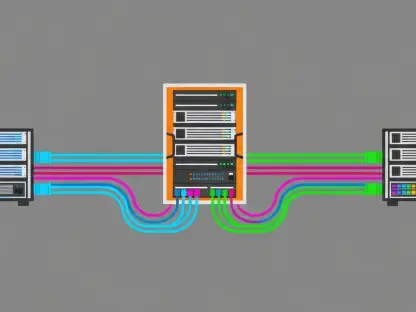In a world where artificial intelligence is becoming the backbone of enterprise innovation, many organizations find themselves grappling with fragmented systems, inconsistent deployment environments, and skyrocketing operational costs that hinder progress. Enter Zipline AI, a dynamic startup founded in 2024, which is rapidly emerging as a transformative force in the AI infrastructure landscape. With a mission to streamline the complex lifecycle of AI development and deployment, Zipline offers a unified platform that integrates data pipelines, serving infrastructure, and observability tools. Backed by a substantial $7 million seed funding round, this company is addressing critical inefficiencies head-on, positioning itself as a vital solution for businesses aiming to scale AI applications. By combining cutting-edge technology with strategic initiatives, Zipline is not just solving technical challenges but also reshaping how industries approach AI adoption, making it a compelling player to watch in this high-growth market.
Zipline’s Innovative Platform and Technology
Addressing AI Infrastructure Challenges
Zipline AI has carved out a niche by tackling the pervasive challenges that enterprises face in managing AI infrastructure, where disjointed data systems and inconsistent environments often stall innovation. At the core of its solution lies Chronon, a powerful data engine developed by Zipline’s founders during their tenure at Airbnb. This technology unifies disparate components of the AI lifecycle, seamlessly integrating data pipelines with observability tools to create a cohesive workflow. Such integration eliminates the need for businesses to juggle multiple platforms, reducing both complexity and operational overhead. For companies striving to deploy AI at scale, this streamlined approach translates into significant time and cost savings, allowing technical teams to shift their focus from managing infrastructure to driving creative solutions that propel business growth. Zipline’s platform stands as a beacon for organizations bogged down by inefficiencies, offering a clear path toward optimized AI deployment.
Beyond unification, Zipline AI’s platform addresses the practical pain points that often accompany AI scaling with a suite of features designed to enhance usability and performance. Capabilities like zero-touch monitoring enable real-time oversight without manual intervention, ensuring that potential issues are flagged and resolved before they escalate. Additionally, automated versioning simplifies updates and model iterations, maintaining consistency across deployment environments. These tools collectively empower businesses to manage AI applications with greater agility, minimizing downtime and boosting reliability. For enterprises in competitive sectors, where speed to market can define success, such efficiency-driven features provide a critical edge. Zipline’s focus on practical, user-centric solutions underscores its commitment to not just meeting but exceeding the demands of modern AI-driven organizations, paving the way for broader adoption across industries facing similar hurdles.
Efficiency-Driven Features
Zipline AI’s emphasis on operational efficiency sets it apart in a crowded field, with features that directly address the bottlenecks inherent in AI deployment. Zero-touch monitoring, for instance, automates the oversight of complex systems, delivering real-time insights into performance metrics without requiring constant human input. This capability ensures that anomalies are detected early, preventing disruptions that could derail critical applications. By reducing the burden on technical teams, Zipline enables enterprises to allocate resources more strategically, focusing on innovation rather than maintenance. The impact of such automation is profound, particularly for businesses managing large-scale AI models where even minor delays can have cascading effects. This forward-thinking approach highlights how Zipline is redefining the standards of infrastructure management, making it an attractive option for companies seeking to optimize their AI operations.
Another cornerstone of Zipline’s platform is its automated versioning system, which tackles the challenge of maintaining consistency across rapidly evolving AI models and datasets. As enterprises iterate on machine learning solutions, ensuring that updates are seamlessly integrated without breaking existing workflows is paramount. Zipline’s technology handles this process automatically, tracking changes and aligning versions to prevent compatibility issues. This not only saves time but also mitigates the risk of errors that could compromise deployment. For industries where precision and reliability are non-negotiable, such as finance or healthcare, this feature offers peace of mind alongside operational gains. By embedding such robust tools into its platform, Zipline demonstrates a deep understanding of the nuanced needs of AI-driven businesses, positioning itself as a trusted partner in navigating the complexities of scaling technology solutions.
Open-Source Strategy and Market Positioning
Community Collaboration and Enterprise Appeal
Zipline AI’s strategic use of an open-source foundation forms the bedrock of its market approach, fostering a collaborative ecosystem while catering to enterprise demands. By building on Chronon as an open-source data engine, Zipline invites developers and organizations to contribute to and benefit from shared innovation, accelerating the refinement of its tools. Simultaneously, proprietary features tailored for enterprise scalability ensure that businesses requiring robust, secure solutions find added value. This dual model strikes a balance between accessibility and premium functionality, driving widespread adoption among diverse user groups. The open-source aspect democratizes access to cutting-edge AI infrastructure, while enterprise-grade enhancements address the specific needs of larger organizations, creating a unique positioning that few competitors can match. This strategy underscores Zipline’s vision of building a broad, inclusive network that fuels long-term growth.
The benefits of Zipline’s dual approach extend beyond accessibility, creating powerful network effects that amplify its market presence. By engaging a community of contributors through open-source channels, Zipline taps into a wealth of collective expertise, continuously improving its platform’s capabilities. At the same time, proprietary offerings cater to enterprises with stringent requirements, ensuring that the platform remains relevant for high-stakes applications. This synergy between community-driven development and tailored solutions enhances Zipline’s appeal, as evidenced by early traction with sophisticated users. Such a model not only accelerates innovation but also builds a self-reinforcing cycle of adoption and improvement. For businesses and developers alike, Zipline offers a compelling blend of collaboration and customization, establishing a strong foothold in the competitive AI infrastructure arena.
Early Traction and Validation
Zipline AI’s early success with prominent industry players serves as a testament to its platform’s viability and market fit. Partnerships with leading entities like OpenAI highlight the trust and confidence that tech-savvy organizations place in Zipline’s technology. These collaborations validate the platform’s ability to handle complex, high-demand AI workloads, reinforcing its reputation as a reliable solution for cutting-edge applications. Such endorsements are critical in a field where credibility can significantly influence adoption rates. By aligning with respected names, Zipline not only gains visibility but also sets a benchmark for performance that attracts other potential clients. This early traction signals a promising trajectory, positioning Zipline as a serious contender in reshaping how AI infrastructure is perceived and implemented across sectors.
Moreover, the validation from early adopters underscores the tangible benefits of Zipline’s approach in real-world scenarios. Working with organizations at the forefront of AI innovation provides Zipline with invaluable feedback, enabling continuous refinement of its platform to meet evolving needs. These partnerships also create a ripple effect, as success stories from prominent clients inspire confidence among other enterprises considering Zipline’s solutions. The resulting network effects strengthen Zipline’s market position, fostering a growing ecosystem of users who contribute to and benefit from the platform’s development. This cycle of validation and expansion is a key driver of Zipline’s momentum, illustrating how strategic alliances can amplify impact. As more industries take note of these achievements, Zipline’s influence in the AI infrastructure space is likely to expand further.
Broader Impact and Strategic Diversification
Educational Outreach and Cross-Sector Applications
Zipline AI’s commitment to broadening the reach of AI extends beyond technology into educational initiatives that empower professionals across various fields. A notable example is the AI-Powered Automated Workflows certificate course launched by Zipline Education in May of this year. This five-week program targets individuals in operations, marketing, and HR, equipping them with practical skills to implement AI tools in their workflows using platforms like Make.com and n8n. By focusing on non-technical audiences, Zipline addresses a critical gap in AI literacy, fostering a deeper understanding of how automation can enhance productivity. Such efforts not only democratize access to AI knowledge but also cultivate a wider user base for Zipline’s solutions, as participants gain hands-on experience with relevant technologies. This initiative reflects a forward-thinking strategy to drive cultural shifts alongside technical advancements.
Equally significant is Zipline’s ability to adapt its platform across diverse industries, demonstrating versatility that amplifies its market impact. Strategic partnerships with entities like Walmart in logistics and healthcare institutions such as Cleveland Clinic and Mayo Clinic showcase the platform’s applicability to varied operational and regulatory environments. In logistics, Zipline supports drone delivery systems, optimizing data workflows for efficiency, while in healthcare, it aids in managing complex datasets for patient care and research. This cross-sector adaptability reduces Zipline’s reliance on any single market, mitigating risks associated with industry-specific downturns. By addressing unique challenges in each field, Zipline proves that its infrastructure solutions are not one-size-fits-all but rather highly customizable, meeting the nuanced demands of different sectors. Such diversification strengthens Zipline’s position as a versatile leader in the AI space.
Investment Potential and Future Outlook
From an investment standpoint, Zipline AI emerges as a high-potential opportunity within a rapidly expanding market, with the AI infrastructure sector projected to grow at a 35% compound annual rate through 2030. The recent $7 million seed funding round, led by Wing VC and supported by Stripe and Box Group, reflects strong investor confidence in Zipline’s vision and capabilities. This capital infusion provides the resources needed for team expansion and platform scaling, positioning the startup for accelerated growth. At a seed-stage valuation, Zipline offers early investors a chance to engage with a company poised to capture significant market share. However, the competitive landscape, with established players like Databricks and emerging startups, presents challenges that require careful navigation. Despite these hurdles, Zipline’s unique blend of open-source and enterprise focus offers a distinct advantage.
Looking ahead, Zipline AI’s future appears promising, though not without calculated risks tied to the fast-evolving nature of AI technologies. The startup’s modular design and governance features for regulated industries provide a buffer against technological shifts, ensuring adaptability as market needs change. Additionally, its lean operation with just seven employees highlights an efficient structure that maximizes output with minimal overhead. For industry observers and potential stakeholders, Zipline represents a timely venture that balances innovation with strategic diversification. Its efforts to build an ecosystem through education and partnerships lay a solid foundation for sustained impact. As challenges from competition and rapid advancements loom, Zipline’s focus on flexibility and community engagement offers reassurance. Moving forward, stakeholders could consider deeper involvement, exploring how Zipline’s scalable solutions might align with broader industry trends to shape the next era of AI infrastructure.









